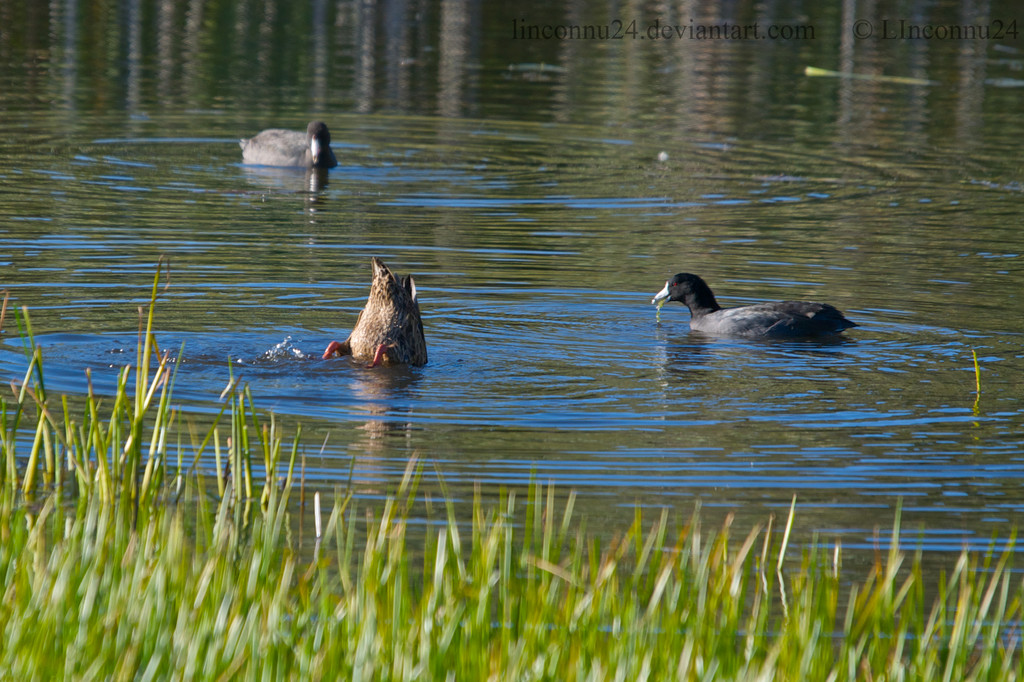HOME | DD
 LInconnu24 — Feeding time
LInconnu24 — Feeding time

Published: 2012-10-29 19:11:22 +0000 UTC; Views: 181; Favourites: 1; Downloads: 0
Redirect to original
Description
A female Mallard (head under water) with two American Coots.Cool Facts:
Although it swims like a duck, the American Coot does not have webbed feet like a duck. Instead, each one of the coot’s long toes has broad lobes of skin that help it kick through the water. The broad lobes fold back each time the bird lifts its foot, so it doesn’t impede walking on dry land, though it supports the bird’s weight on mucky ground.
American Coots in the winter can be found in rafts of mixed waterfowl and in groups numbering up to several thousand individuals. The ecological impact of common animals, like this ubiquitous waterbird, can be impressive when you add it all up. One estimate from Back Bay, Virginia, suggested that the local coot population ate 216 tons (in dry weight) of vegetation per winter. The oldest known American Coot lived to be at least 22 years 4 months old.
Habitat:
Lake/Pond
The American Coot inhabits a wide variety of freshwater wetlands from prairie potholes to swamps and marshes to suburban park and sewage ponds to the edges of large lakes. Two features generally characterize all bodies of water where coots breed: heavy stands of emergent aquatic vegetation along at least some portion of the shoreline and at least some depth of standing water within those stands of vegetation. Seasonal wetlands used during years of high water, while drought years cause breeding to be limited to permanent wetlands.
Food:
Eats mainly aquatic plants including algae, duckweed, eelgrass, wild rice, sedges, hydrilla, wild celery, waterlilies, cattails, water milfoil; when on land they also pick at terrestrial plants and sometimes eat grains or leaves of oak, elm, and cypress trees. They’re not exclusively vegetarian. You may also see them eating insects (beetles, dragonflies, and others), crustaceans, snails, and small vertebrates such as tadpoles and salamanders.
Nesting Facts:
Clutch Size
8–12 eggs
Number of Broods
1-2 broods
Egg Length
1.7–2.2 in
4.3–5.5 cm
Egg Width
0.8–1.5 in
2–3.7 cm
Incubation Period
23–25 days
Egg Description: Buff, pinkish buff or buff-gray speckled with dark brown, purplish brown, or black. Condition at Hatching. Covered in down, alert, ready to leave the nest within 6 hours of hatching.
Nest Placement
Floating
Nests are almost always built over water on floating platforms and almost always associated with dense stands of living or dead vegetation such as reeds, cattails, bulrushes, sedges, and grasses. Occasionally, the nest may be built on the edge of a stand of vegetation, where it is clearly visible.
Behavior:
Surface Dive
A slow and meticulous forager, the American Coot plucks at plants while walking, swimming, dabbling with its head just underwater, or in full dives. In flight coots are clumsy and labored (though less so than Common Moorhens). To get airborne, coots typically have to beat their wings while running across the water for many yards. Coots sometimes gather in winter flocks of several thousand, sometimes mixing with other waterfowl. They sometimes steal food from others including ducks. Coots sometimes lay their eggs in the nests of other coots as well as Franklin’s Gulls, Cinnamon Teal, and Redheads.
Conservation:
Common and widespread. Coot aren’t hunted nearly as much as ducks since many hunters consider them inedible. Some hunters shoot them for sport, particularly in Louisiana, California, Florida, Wisconsin, and Minnesota. In 1999 the annual harvest of coots in the U.S. was about 720,000. Because they live in wetlands, coots can accumulate toxins from pollution sources including agricultural runoff, industrial waste, and nuclear facilities. Because coots are so common and widespread, scientists sometimes monitor them as a way of monitoring these problems in the environment at large.
-----
Its European cousin:























